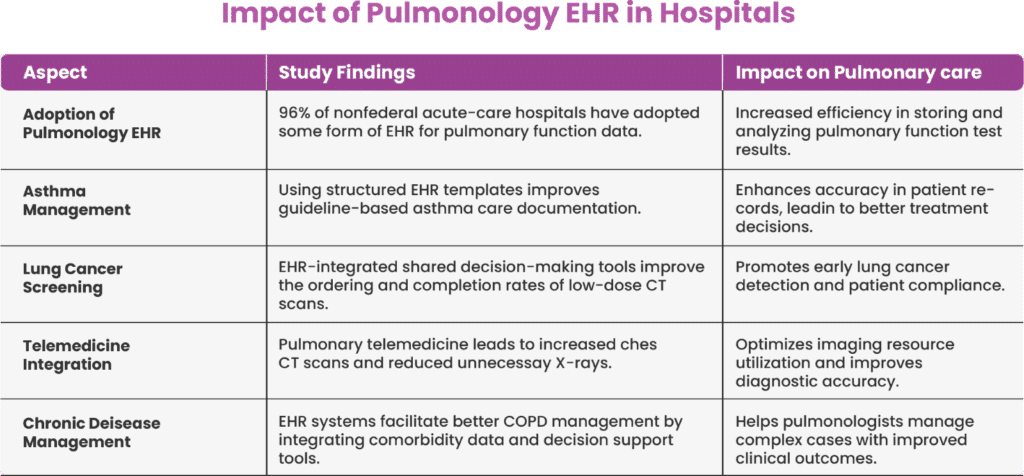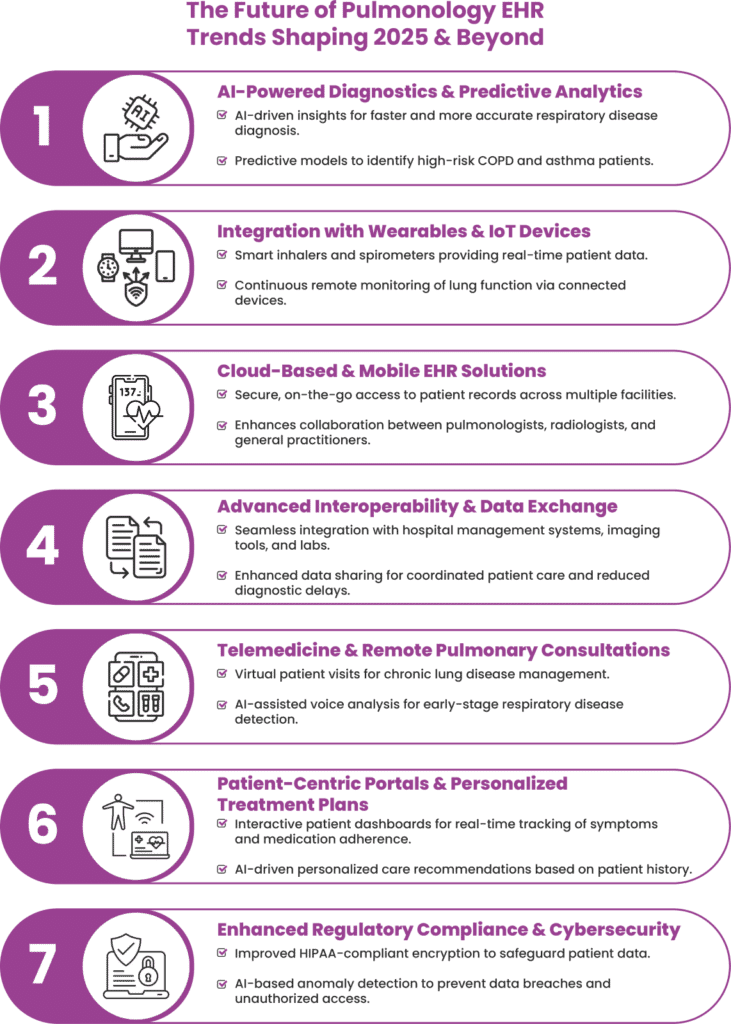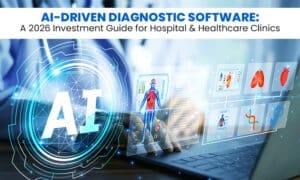
Pulmonologists play a critical role in diagnosing and treating diseases of the respiratory system, ensuring patients receive optimal care for conditions like asthma, COPD, and interstitial lung disease. However, managing pulmonology practice is not without challenges.
From tracking complex diagnostic data to managing long-term patient records and coordinating care across multiple departments, pulmonologists require a specialised medical health record system that caters to their unique needs. A well-designed pulmonology EHR (Electronic Health Record) system provides a solution by streamlining workflows, improving patient management, and enhancing decision-making through AI-powered insights.
Understanding Pulmonology Treatment and Procedures
Pulmonology is a specialised field focusing on diseases affecting the respiratory system, including the lungs, airways, alveoli, and pleura. Pulmonologists use a variety of procedures to diagnose and treat these conditions, including:
- Pulmonary Function Tests (PFTs): These tests measure lung capacity and airflow to diagnose asthma, COPD, and other disorders.
- Bronchoscopy: A procedure that allows pulmonologists to visually examine the lungs and airways using a flexible scope.
- Sleep Studies: Used to diagnose sleep apnoea and other breathing disorders.
- Thoracentesis: A technique to remove excess fluid from the pleural space around the lungs.
- Biopsies and Imaging: Including CT scans and MRIs to detect lung nodules and other abnormalities.

Benefits of Pulmonology EHR for Doctors and Patients
Pulmonology-specific electronic medical record systems offer numerous benefits, improving both physician efficiency and patient care. Some of the key advantages of advanced medical health record system include:
1. AI-Powered Decision Support
Modern medical health record system uses Artificial Intelligence (AI) to analyse patient data and provide predictive analytics. AI-driven EHR systems can:
- Identify early signs of lung diseases.
- Suggest personalised treatment plans based on historical data.
- Provide automated alerts for abnormal test results.
2. Comprehensive Patient Records
Integrated electronic medical record systems provide a 360-degree view of patient history, including previous diagnoses, test results, and treatment plans. This pulmonology EHR ensures better coordination among specialists and minimises errors in patient management.
3. Enhanced Workflow Efficiency
A pulmonology EHR system automates administrative tasks, reducing paperwork and allowing pulmonologists to focus on patient care. With built-in templates for respiratory conditions and diagnostic reports, doctors can streamline documentation and save valuable time.
4. Telemedicine Integration
With the rise of virtual healthcare, pulmonology electronic medical record systems now feature telemedicine capabilities, allowing doctors to conduct remote consultations and monitor patients with chronic respiratory diseases without frequent hospital visits.
5. Automated Billing and Coding
EHR systems simplify medical billing by automatically coding procedures and diagnoses, reducing the risk of claim denials and ensuring timely reimbursements for pulmonologists.
6. Improved Patient Engagement
Patient portals integrated with pulmonology electronic medical record systems allow individuals to access their medical records, schedule appointments, and communicate with their doctors, leading to higher satisfaction and better adherence to treatment plans.

Key Trends in Pulmonology EHR Solutions for 2025
1. AI-Driven Predictive Analytics
AI will play an even greater role in pulmonology EHRs, identifying disease patterns and suggesting proactive treatment options based on real-time data.
2. Cloud-Based EHR Systems
Hospitals and clinics are moving towards cloud-based medical health record system for better accessibility, scalability, and data security.
3. Mobile-First EHR for Pulmonologists Access
With mobile applications, pulmonologists can now access patient records on the go, improving response time for critical cases.
4. Enhanced Data Interoperability
Interoperability between pulmonology EHRs and hospital management systems will ensure seamless data exchange, reducing redundancy and improving coordinated care.
5. Remote Patient Monitoring (RPM) Integration
More electronic medical record systems will include integrated RPM features, allowing real-time monitoring of patients with chronic respiratory conditions from their homes.
Conclusion
An EHR for respiratory specialists goes beyond simply recording patient data—it transforms how pulmonologists diagnose, treat, and manage respiratory conditions. With AI-driven decision support, telemedicine capabilities, and seamless integration with hospital workflows, these advanced solutions enhance efficiency, improve patient outcomes, and streamline compliance with healthcare regulations.
If you’re looking to implement a specialised Pulmonology EHR for your hospital or clinic, now is the perfect time to explore modern solutions that can revolutionise your practice.





